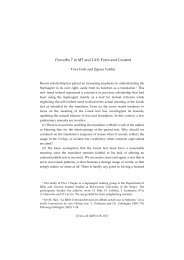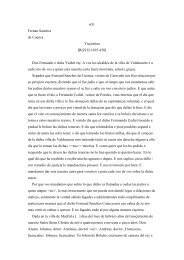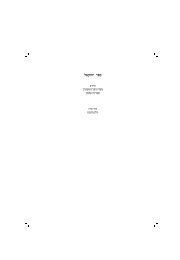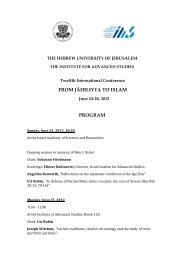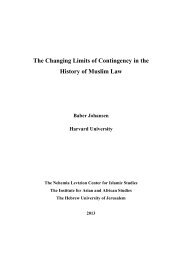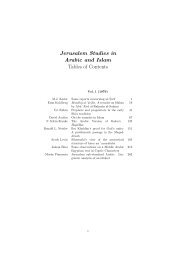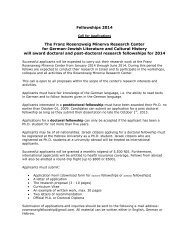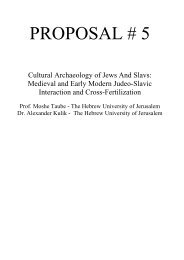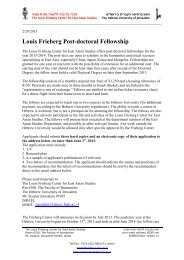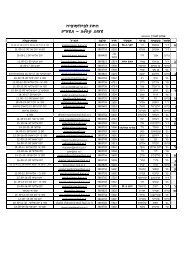THE BOOK OF EZEKIEL Moshe H. Goshen-Gottstein Shemaryahu ...
THE BOOK OF EZEKIEL Moshe H. Goshen-Gottstein Shemaryahu ...
THE BOOK OF EZEKIEL Moshe H. Goshen-Gottstein Shemaryahu ...
Create successful ePaper yourself
Turn your PDF publications into a flip-book with our unique Google optimized e-Paper software.
VI. Apparatus IV: Orthography, Vowels, and Accents<br />
Method of Recording<br />
85. ` was fully collated 126 with all these manuscripts. When no variant is recorded, agreement<br />
with ` can be assumed only for MS l, 18l, 1w (except for 29:5–30:6), and y, and with<br />
regard to t and x, only for the consonantal text. The remaining manuscripts are incomplete,<br />
precluding any assumption of agreement based on silence. Doubtful readings are indicated<br />
by a question mark, and clear scribal errors are marked with an exclamation point. 127 Particulars<br />
of convention were not recorded, viz., the manner of writing holam . in the divine<br />
epithets i pc` and dedi, the manner of indicating segolta (with the point upward or downward),<br />
etc. All sources were counterchecked; wherever a variant was found in one, the text<br />
of the others was re-examined.<br />
86. In this entirely non-verbal apparatus, 128 variants in the sources mentioned in the previous<br />
paragraphs are listed in the apparatus after the lemma (from `) in alphabetical and<br />
numerical order, with n adduced last (from right to left): 30 29 28 25 23 20 18 14 10 4l l<br />
n y x 1w w t p 37 35 32. With regard to differences in vocalization or accents, in the lemma<br />
only the letter or letters exhibiting a variant are vocalized, and in quoting the witnesses only<br />
those letters are recorded. Diverse details in one word are noted separately, divided by a<br />
semi-colon (;) according to their order. The original reading of a manuscript is marked by<br />
a single apostrophe ('), parallel to the symbol ‘pm’ in Apparatuses II and III. The changed<br />
reading is marked by a double apostrophe (''), parallel to ‘sm’. 129 Rarely is a third-stage<br />
correction indicated by three apostrophes ('''). The possible reasons for such corrections are<br />
not discussed.<br />
87. The following symbols and abbreviations are used in apparatus IV: 130<br />
< omission<br />
.. before completing the word, the scribe erased or corrected letters he began<br />
to write<br />
′ prima manus (before correction)<br />
′′ secunda manus (after correction)<br />
′′′ tertia manus (a correction of a correction)<br />
< > reconstructed text (in the masora magna or parva)<br />
? a doubtful reading (due mainly to damage in the manuscript)<br />
126 Differences concerning rafe-strokes are not recorded, just as they are not recorded in the basic text;<br />
see above, §26. For a comprehensive list of open and closed sections, see the Appendix.<br />
127 In view of the carelessness evident in their copying, scribal errors were not recorded for MS 4l, 10l,<br />
and 25l. In contrast, unusual vocalizations in 14l were recorded, since there is reason to assume that<br />
the scribe may have entered them intentionally.<br />
128 When the variant involves an un-pointed letter, letters, or entire word, this is verbally indicated (in<br />
Hebrew).<br />
129 These signs mark additions, erasures, corrections, etc. The notation 'l, 'x, etc. indicates that<br />
presumably the manuscript originally differed from `, and that only its corrected reading can be<br />
identified with that of `.<br />
130 For a complete list of masoretic terminology and abbreviations cf. I. Yeivin, The Biblical Masora<br />
(Studies in Language 3; Jerusalem: The Academy of the Hebrew Language, 2003) 72–79 (Hebrew).<br />
xliii



